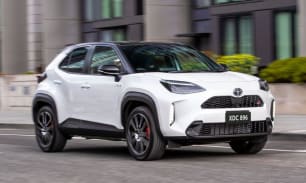Very. As with all Yaris Cross models, the GR Sport Hybrid is designed to be easy to live with, with ample roof height, large doors and hip-level seating to aid entry/egress. No kneeling down to sit inside or hauling yourself up exiting this small SUV.
Comfy and embracing, the sporty front bucket seats seem to offer better support and location than the regular seats, and – as with the rest of the cabin's finish and ambience – are great to behold. It's smart and sassy in there.
Once settled in, the Japanese giant's smallest SUV continues to impress with its sense of space and pleasing all-round vision, making this seem larger than its city-slicker badge implies.
Nothing cramped or tight to report here – unless you're a basketballer perched high on the front passenger seat. Please, Toyota, provide the option of a lowering lever.
Aided by an amenable driving position, simplicity remains the name of the game, as demonstrated the tactile three-spoke wheel, wide adjustability of seating and steering column, unobstructed views of the attractive dash and effortless access to switchgear. If you run a driving school then here's a great lesson in elementary vehicle operation.
That said, the big digital speedo is not up high in the driver's direct sightline; you'll need to do a switcheroo with an Urban grade and its head-up display to remedy that, while the centre screen's layout can be a bit fiddly at first to figure out, though all necessary info is present.
With no shortage of storage, including 1.5-litre bottle-ready door bins and lots of areas to leave stuff in or on securely, effective ventilation and a sense of hardy quality, it's easy to imagine the Yaris Cross appealing to a broad array of buyers, whether singles, families or Empty Nesters.
It's that sort of do-it-all for less packaging that makes you question spending more for a larger SUV.
Downsides? As well as denying us front passenger seat height adjustment, Toyota seems to see no reason to provide its up-spec crossover with a front centre armrest, driver's seat lumbar support and wireless smartphone charger.
Maybe that's why the centre screen's graphics are so Nokia-esque. Plus, rear vision is hindered by fixed tombstone-style headrests out back. Remember when carmakers used to hollow them out to avoid such blind spots?
The Yaris Cross' rear-seat area benefits from lofty seating, a high ceiling to clear scalps, reasonable kneeroom and space beneath the front seats for big boots to tuck in under. But we'd think twice about squeezing three larger people abreast as shoulders and thighs would likely rub.
Still, outboard-sited passengers should rate the well-angled backrests and shapely cushion offering sufficient thigh support. Note that nothing slides or reclines back there.
Other observations? The 40/20/40 backrest's middle portion folds to reveal a pair of cupholders, like in a BMW. Useful, too, are more bottle-friendly door storage (up to 600ml), reading lights, a single map pocket, two coat hooks and auto up/down electric windows.
Some might miss the lack of face-level air vents, though nobody complained about it being stuffy back there.
Moving to the luggage compartment, a flimsy, fiddly, foldable fabric mesh cover is your only defence from prying eyes, and this is a poor substitute for a parcel shelf; Toyota, if you must, please check out how Honda's Civic does it.
Otherwise, the news is positive, due to a sizeable loading cavity, long flat floor and VDA-rated luggage capacity of up to 390L with rear seatbacks up in situ.
Check out the novel 60/40-split false floor, which provides some degree of extra out-of-sight security as well as loading versatility.
As with all Yaris Cross 2WDs, there's a space-saver spare below that. Going AWD means you'll have to put up with a tyre-repair kit – something we'd not inflict on anybody - as well as a substantially smaller cargo capacity (down to just 314L VDA).
Overall, with its subtle yet effective sporty accents and tasteful trim choices, the GR Sport Hybrid enhances an already generally thoughtfully presented and executed Yaris Cross interior.



















































 copy.png)











